HOW TO COOK STEAK IN THE OVEN
My favorite method for how to cook steak in the oven. Steak is surprisingly easy to prepare and cook in the oven to your desired degree of doneness, and just as delicious as ever!
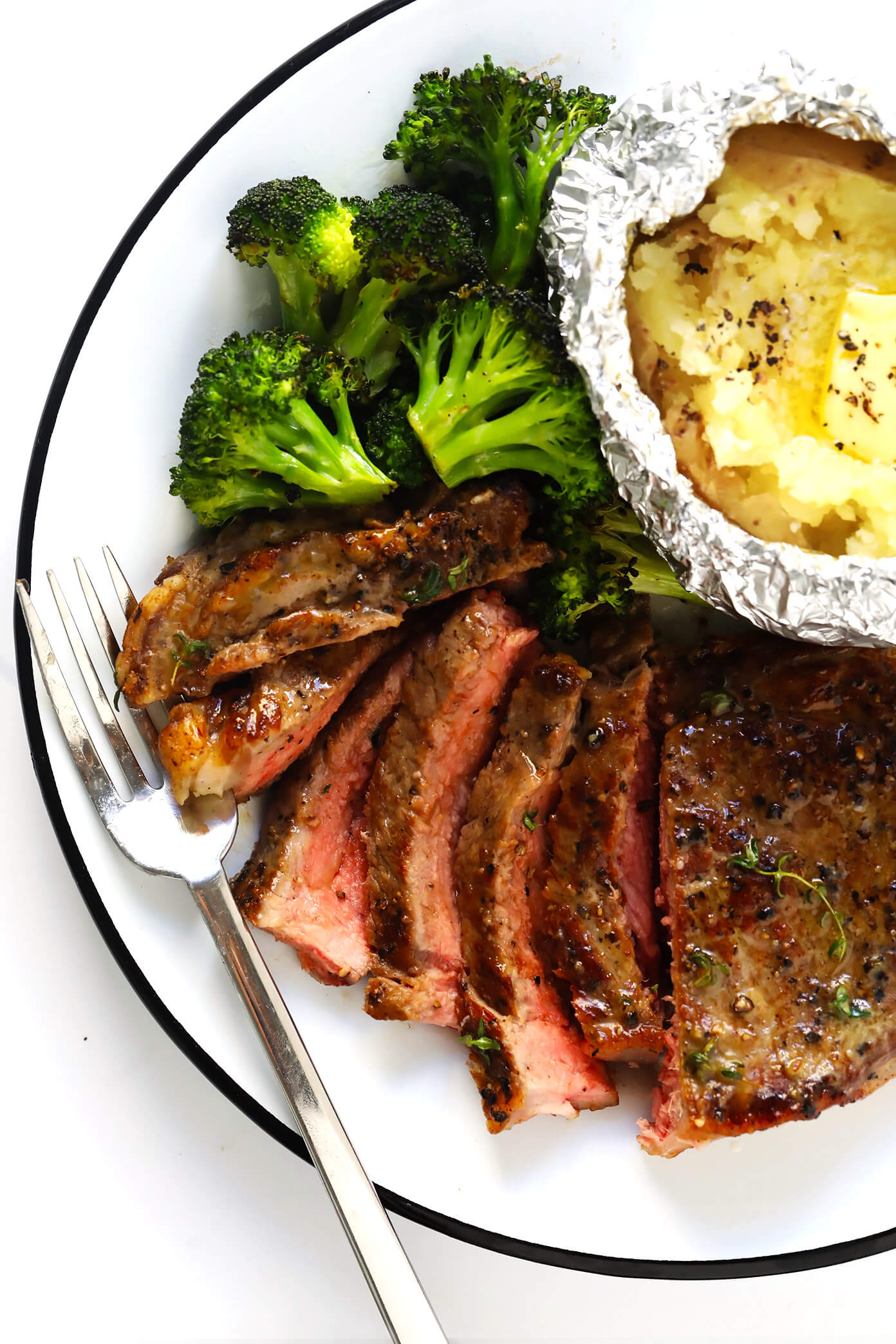
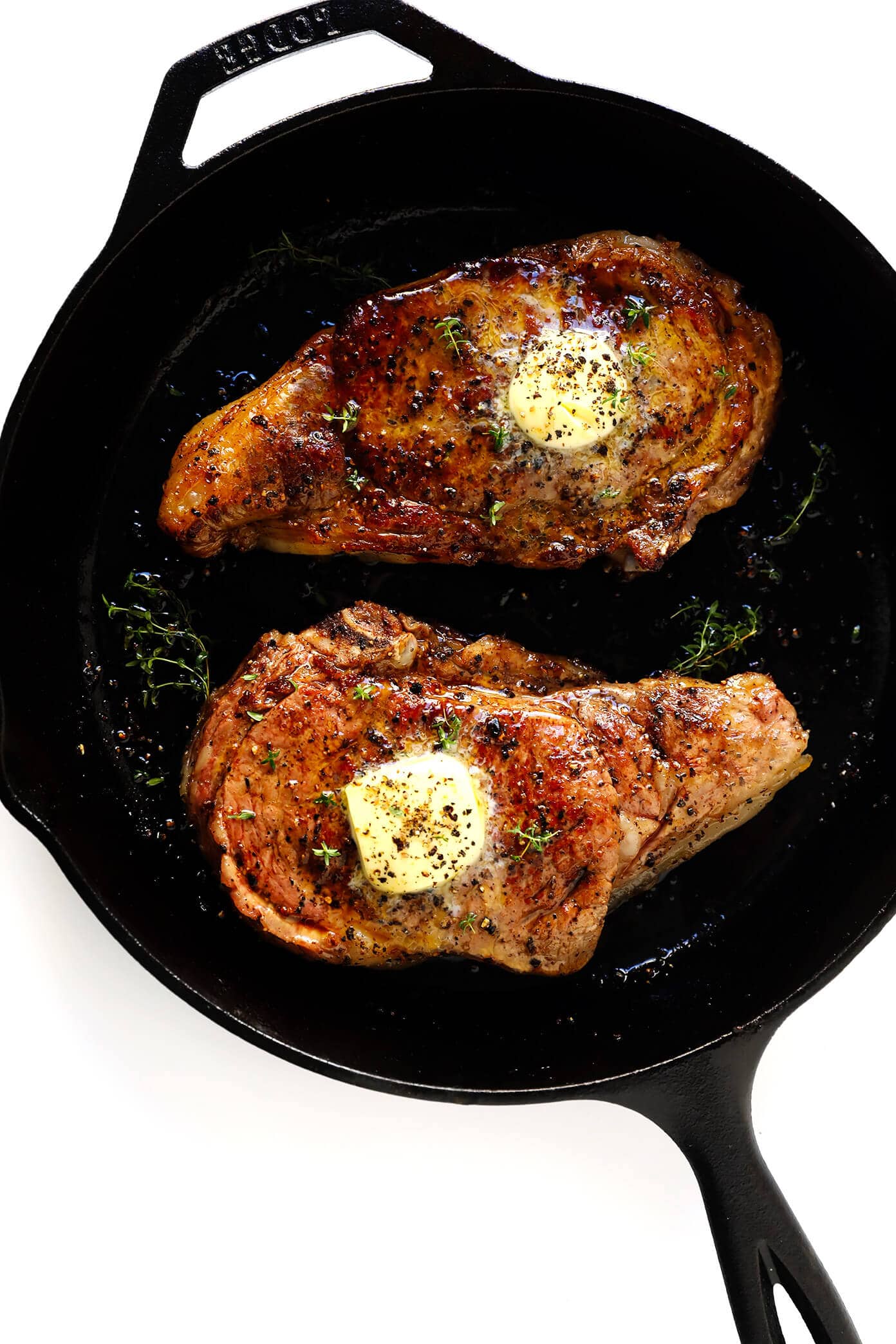
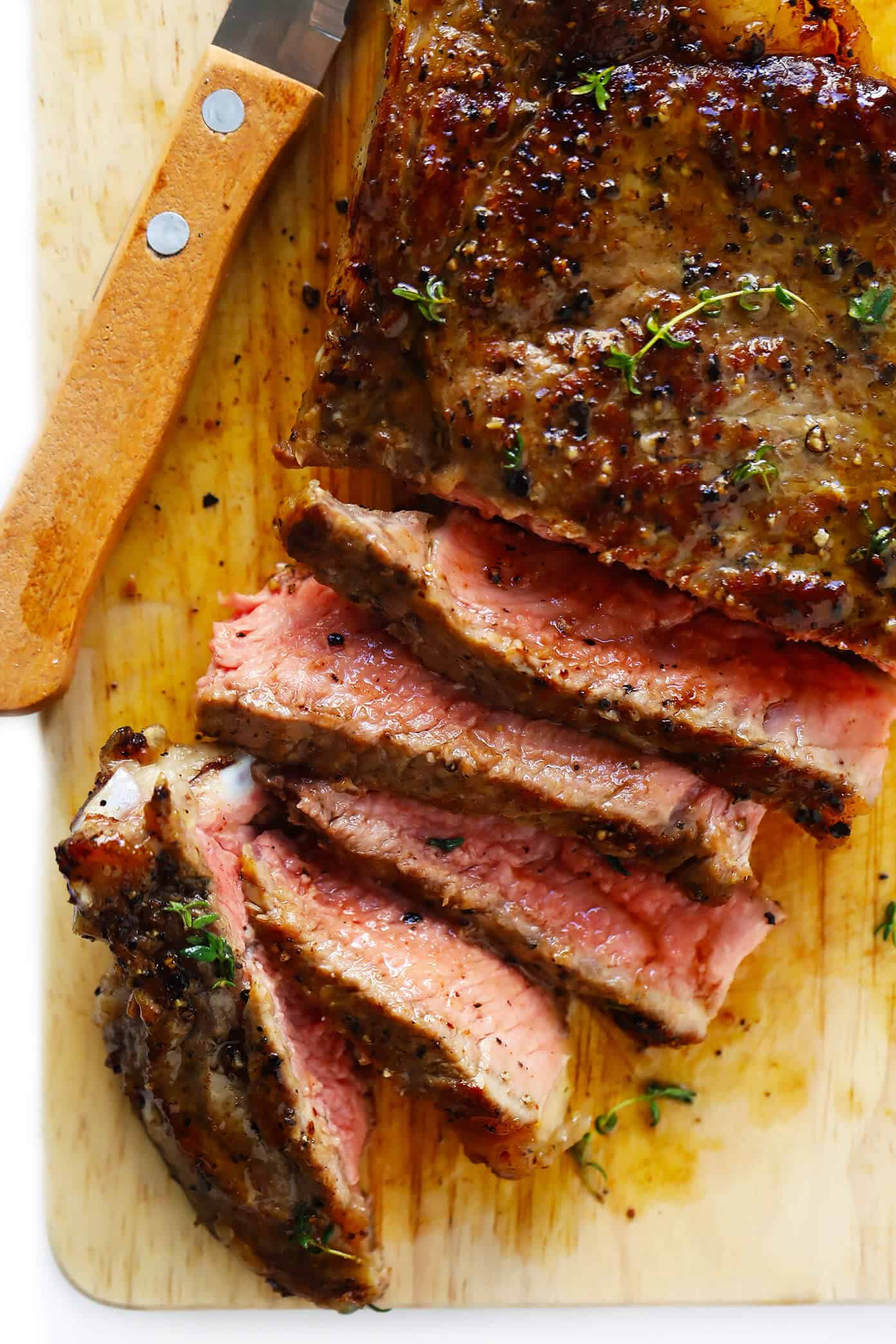
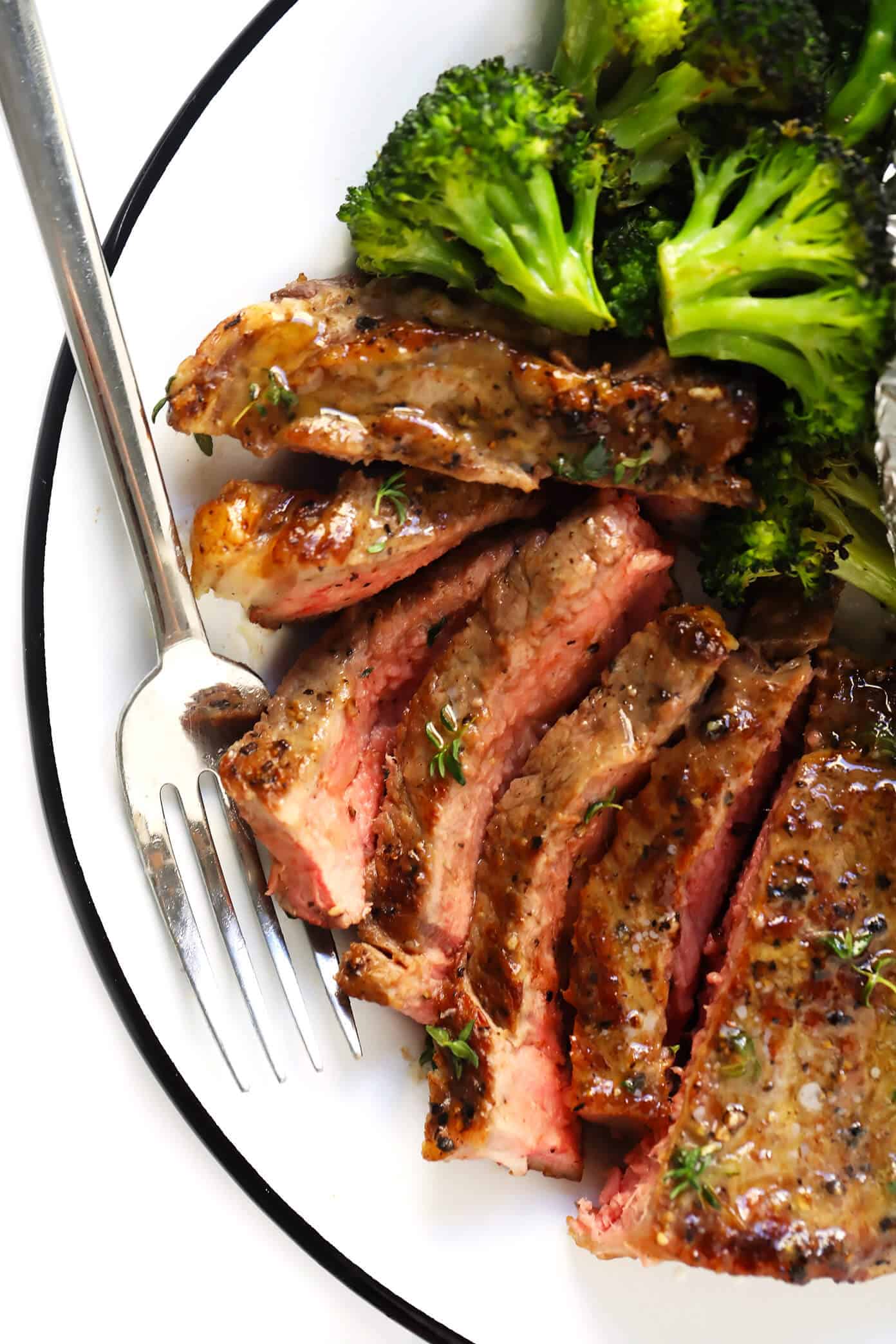

One of the random downsides about our apartment here in Barcelona? We’re not allowed to have a grill.
I didn’t think it would be a huge deal when we moved in. But of course, the second you can’t have something, it instantly becomes the thing you totally crave — right?! Especially during these warmer months, I’ve been craving all of my favorite grilled skewers and burgers and peaches like crazy. So instead of missing out, we decided to get crafty this summer, and up our indoor roasting-everything-in-the-oven game. (Which — hey — seems apropos for the girl who named her blog Gimme Some Oven.) And of course, squarely in the middle of the things-I’ve-always-grilled-but-now-cook-in-the-oven category is one of my faves:
I actually eat very little meat nowadays, and try to reserve it more for just special occasions. But when I do go for it, my favorite protein will probably forever and always be a nice, juicy, perfectly-cooked steak. What can I say — I was raised in the Midwest and still love a good meat and potatoes meal every now and then. Especially when the steak is organic and grass-fed. Especially when it’s well seasoned. And — since steak is already a special occasion food for me anyway — especially with a generous melty pat of butter on top. Total treat.
That said, after cooking steaks on the grill my entire life, I will be the first to admit that I was very skeptical that steak could be cooked properly in the oven. But as it turns out, it actually works really well! It nails that perfectly seared and crispy crust on the outside, and still lets you choose your desired degree of doneness on the inside. It’s only takes about 10 minutes to make, and it’s easy to customize with your favorite seasonings or steak marinades. And hey — during those cold winter months — it’s a comfortable way to cook steak from the comfort of your kitchen, instead of

OVEN BROILED STEAK INGREDIENTS & COOKING TOOLS:
To make this baked steak recipe, you will need:
- Steak: When it comes to purchasing steak, I recommend looking for:
- Good-quality: It’s important to me that any beef I buy is organic, grass-fed, and sustainably-raised. It’s more ethical, plus always tastes better.
- Thick-cut: This oven method will be much more forgiving if your steak is at least 1- to 1.5-inches thick. (If not, just keep a closer eye on the steak to ensure that it doesn’t overcook.)
- Your preferred cut: I recommend filet mignon, rib-eye, T-bone, flank steak, sirloin, strip steak, or whatever your favorite cut of steak may be.
- Oil: Whatever your preferred high-heat cooking oil may be. I like to use avocado oil for this recipe.
- Seasonings: I typically like to use a simple garlic powder, salt (or seasoned salt) and black pepper seasoning blend with steak. And then serve it up with a pat of butter and maybe a sprinkle of fresh thyme. But feel free to use whatever other dry seasonings or steak marinades that you prefer.
You will also need (affiliate links included):
- An oven-proof skillet: I highly-highly-highly recommend using a cast-iron skillet (or a cast-iron Dutch oven) if you have one. It will hold heat the best and cook the steak most evenly. But if not, any oven-proof skillet that can sustain high heat will also work.
- Tongs: These will be essential for flipping the steak as it is searing. I recommend these 12-inch tongs from OXO.
- An instant-read thermometer: I really feel like this is a must with cooking steak in the oven. A cooking thermometer is the best way to ensure with 100% accuracy that your steak reaches your exact degree of doneness (i.e. rare, medium-rare, medium, medium-well, well-done). And it is helpful with cooking many other proteins besides steak too. I recommend this:
- Dual-probe wireless meat thermometer: which I also own and love because it can be used inside of a hot oven (especially helpful for baking pork, salmon, steak and chicken), which retails for about $24.99 on Amazon.
- Instant-read cooking thermometer: which I have owned and used for years, which retails for about $9.99 on Amazon. (Only downside is that it cannot be used inside the oven.)
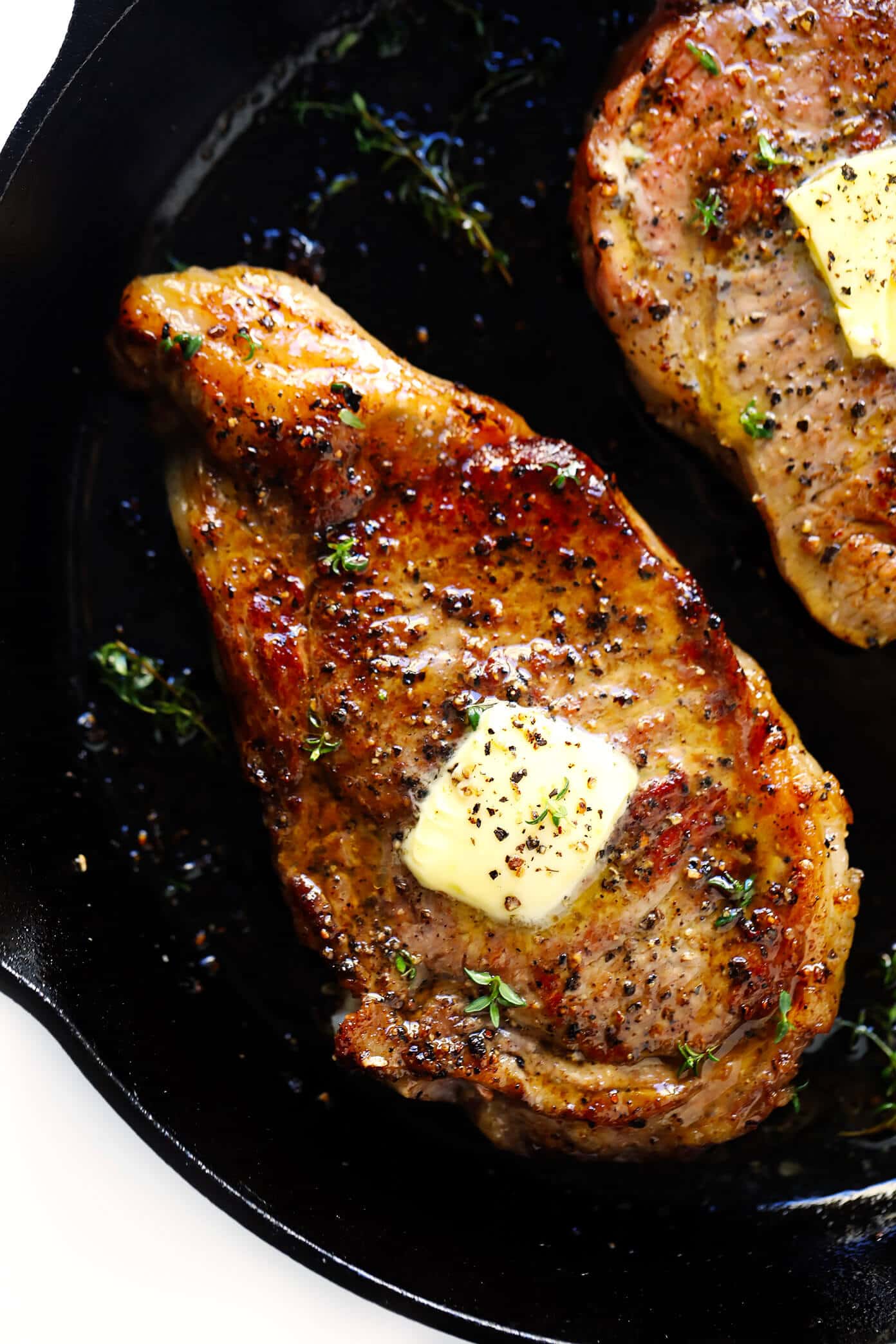
HOW TO COOK STEAK IN THE OVEN:
They keys to cooking steak in the oven are pretty simple: you need to begin with room temperature steak, sear it in a screaming hot skillet, broil it the rest of the way in the oven until it reaches your desired level of doneness, and then let the steak restfor a few minutes to lock in those juices. As I mentioned above, I also really, really recommend using a cooking thermometer to measure the internal temperature of the steak and ensure that it has reached your desired level of doneness. It will be a huge help, especially if you’re picky about the exact level of doneness.
So, let’s talk specifics! To steak in the oven, simply:
- Begin with room-temperature steak. Let it rest out on the counter for 30-45 minutes or so, until it comes fully to room temperature. This is always essential with cooking any kind of steak. Near the end of this time, go ahead and preheat the broiler on your oven.
- Season the steak. Blot the steak dry with paper towels. Then brush on both sides with oil. Sprinkle with your desired dry seasonings. (I like a mixture of garlic powder, kosher salt and black pepper.)
- Pre-heat your skillet. Meanwhile, as you’re seasoning the steak, heat your skillet over high heat on the stove for about 6-8 minutes, until it is super-hot. Once your steak is seasoned and your skillet is ready…
- Sear the steak on one side. Place the steak in the hot skillet (carefully, so that the oil doesn’t splatter). Then give the tops of the steak a gentle press down with a spatula, so that the full bottom surface of the steak makes contact with the pan (instead of accidentally curving up). Cook for 30 seconds. Then flip the steak over, and quickly…
- Transfer pan to the oven and bake. Carefully use an oven mitt to move the entire pan to the oven, where the second side of the steak will continue to sear. Broil for 3 minutes, then flip the steak. Broil for another 2-3 minutes more, or until the steak reaches 5° below your desired level of doneness. (The steaks will continue to cook a bit more once they are removed from the oven.) Doneness temperatures, measured in the thickest part of the steak, are as follows:
- Rare: 125°F or 52°C (Remove from the oven at 120°F or 49°C.)
- Medium-rare: 135°F or 57°C (Remove from the oven at 130°F or 54°C.)
- Medium: 145°F or 63°C (Remove from the oven at 140°F or 60°C.)
- Medium-well: 150°F or 66°C (Remove from the oven at 145°F or 63°C.)
- Well done: 160°F or 71°C (Remove from the oven at 155°F or 68°C.)
- Transfer steak to a clean plate. Then use a pastry brush to brush any of those extra juices in the pan onto the steak (that’s where so much of the flavor is hiding!). Tent the plate with aluminum foil and…
- Rest the steak. Let the steak rest for 3 minutes, to lock all of those delicious juices in. Once the steak is ready to go…
- Serve warm! And enjoy!
Once the steak has been cooked, it can be stored in a sealed container in the refrigerator for up to 3 days. Or you can freeze it for up to 3 months. (<– I recommend slicing, dicing or shredding the steak before freezing for easier use.)
**Also, one important note — the steak will definitely be very smoky as it is cooking! So be sure to turn on an exhaust fan above your stove (if you have one) or open a window.

STEAK MARINADES AND SEASONINGS:
When it comes to steak seasoning, I’m a big fan of the simple garlic powder/salt/pepper mix in the recipe below, which goes with just about any cuisine. (Or I also really love subbing in seasoned salt in place of regular kosher salt.) But if you’d like to mix things up, feel free to sub in any of your favorite dry seasoning mixes. Or check out these 5 easy steak marinade recipes. And of course, feel free to also serve your steak with any favorite finishing sauces as well.

HOW TO COOK STEAK IN THE OVEN
My favorite method for how to cook steak in the oven. Oven-broiled steak is surprisingly easy to prepare and cook to your desired degree of doneness, and just as delicious as ever!
INGREDIENTS:
- 2 good-quality steaks, room temperature, ideally about 1 to 1.5-inches thick (such as filet mignon, rib eye, T-bone, strip steak, sirloin, flank steak, or your preferred cut of steak)
- 2 tablespoons high-heat oil (such as avocado oil, canola oil, etc.)
- 1 teaspoon kosher salt
- 1/2 teaspoon freshly-cracked black pepper
- 1/2 teaspoon garlic powder
DIRECTIONS:
- Preheat broiler on your oven. Let the steaks rest on a plate until they have fully reached room temperature.
- In a small bowl, whisk together the salt, pepper, and garlic powder until combined. Set aside.
- Blot the steaks dry with paper towels. Then brush evenly on both sides with oil, and sprinkle the seasoning mixture evenly on both sides of the steaks.
- Meanwhile, heat a cast iron skillet (or oven-safe sauté pan) on the stove over high heat for 6-8 minutes. Once the pan is super-hot, add the steaks and use a spatula to press them evenly into the pan, so that the entire bottom surface of the steaks makes contact with the pan. Cook for 30 seconds.
- Carefully use tongs to flip the steaks. Then use an oven mitt to carefully transfer the skillet to the oven. Broil for 3 minutes. Then flip the steaks once more, and continue baking for 2-3 minutes more, or until the internal temperature of steak reaches 5 degrees below your desired level of doneness (see chart below). The steak will continue cooking a bit after you remove it from the oven.
- Once the steaks are ready to go, immediately remove the pan from the oven, and transfer the steaks to a clean plate. Brush any of the pan juices onto the steak. Then loosely tent the plate with aluminum foil and and let the steak rest for at least 3 minutes.
- Serve warm. Or, refrigerate in a sealed container for up to 3 days, or freeze for up to 3 months.
- Recipe slightly adapted from Alton Brown.
- Doneness internal temperatures for steak are as follows (measured in the thickest part of the steak):
- Rare: 125°F or 52°C (Remove from the oven at 120°F or 49°C.)
- Medium-rare: 135°F or 57°C (Remove from the oven at 130°F or 54°C.)
- Medium: 145°F or 63°C (Remove from the oven at 140°F or 60°C.)
- Medium-well: 150°F or 66°C (Remove from the oven at 145°F or 63°C.)
- Well done: 160°F or 71°C (Remove from the oven at 155°F or 68°C.)
- The FDA recommends that steak be cooked to an internal temperature of 145°C or 63°C.
Recipes Adapted By www.gimmesomeoven.com
BERITA LENGKAP DI HALAMAN BERIKUTNYA
Halaman Berikutnya
0 Response to "HOW TO COOK STEAK IN THE OVEN"
Posting Komentar